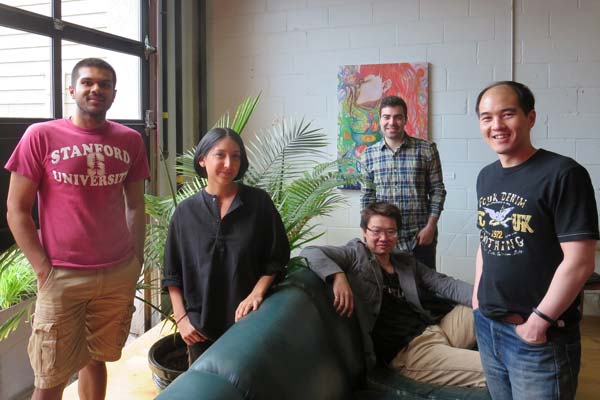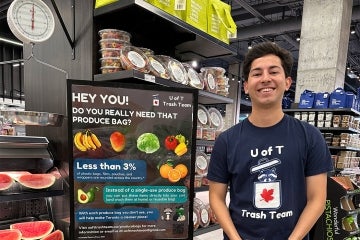
Pay for Summerlicious restaurant meals and more with the tap of a finger: U of T alumni startup, Tab
Published: July 7, 2014
It may not be able to add more salt, less sauce or bring you second helpings – but thanks to a new startup called Tab from U of T alumnus Fahd Ananta, your smartphone can, in fact, offer a better dining experience in Toronto.
“Taking the cheque has always been a downer at the end of a restaurant meal,” read a recent feature on Tab in the Globe and Mail. “Wouldn’t it be nicer to just get up, walk away, and have the bill sort itself out?” (Read the Globe feature here)
Solving that problem with two finger-taps on a smartphone is the promise of Tab. (Read more about Tab)
“Tab is a way for people to pay in restaurants with their phone,” says Ananta.
Seems simple when he puts it like that. But Tab not only gets rid of the pain of waiting for a bill (and having to calculate and add the tip in front of a hovering server). It also adds perks, as users can provide feedback and access coupons and other incentives.

With a growing roster of more than 20 influential Toronto restaurants already using the service—including Weslodge and Brassaii, both taking part in the Summerlicious festival running July 4-20—and plans for expanding to food trucks and quick service spots in the city, Tab has earned impressive territory since launching in January. (Learn more about Summerlicious)
It’s the second promising startup from Tab co-founder Ananta, whose last project, Chime, was acquired by a US firm called Hubspot in 2013.
(Read the U of T News feature on Chime’s acquisition)
Ananta explained his take on Tab, what he learned from launching Chime, and the best motivations for being a globally minded entrepreneur working in the Toronto scene.
Why do customers and restaurants use Tab?
Tab solves the problem of having to wait for the bill. From the consumer perspective, you sit around, you wait for the bill, hand the server this piece of plastic, they punch in a bunch of numbers, and you have to do that multiple times if a table splits the bill. With Tab, you just each pay with your phone.
From the restaurant perspective, Tab ‘closes the loop’ on the transaction: usually they’re able to give you customer service but they’re not really able to ask you, ‘How was your service?’ And for them to get quantifiable feedback in return for a coupon or offering a discount in the future if you had terrible service, it really gives them a closed loop, and that’s valuable.
What obstacles have you overcome to get where you are with Tab?
If you consider this like a race, we’re not even like one per cent of the way there, but some of the obstacles we’ve leapt over are the initial stuff like growing a team, getting into the first five restaurants – because you have to prove your solution from scratch – getting user adoption.
We’re aiming to beat the previous week in terms of number of “Tabs” processed, but most people only go out to eat on like Friday, Saturday, Sunday, so it’s like we’re waiting from Monday - Thursday super stressed- out, thinking, “We’re not going to beat the goal, we’re not going to beat the goal!” And then Friday, Saturday come around and it’s like, okay, cool. And then you start all over again.
How did you clinch the deal with those first few restaurants to use Tab?
We have a set of value propositions for restaurants that include, ‘turn tables over faster,’ ‘higher tips,’ ‘people spend more money,’ ‘they don’t have to relate the restaurant experience with the pain of swiping their card and waiting.’
From that set of values, every restaurant has liked a different one of them. Restaurant A might say, “I really like that you do next-day payouts,” where Restaurant B might say “I don’t care so much that you’re doing next-day payouts, but you guys let us do faster turnover.”
The way it worked for the first few, we had intros from some of our investors, we gave them preferred rates, worked with them side-by-side. And we’re still doing that. They say if you make 100 people really love your product, that’s what gets success. We’re still working with it.
What did you learn from launching and selling your first startup, Chime?
I learned it was very tough and I shouldn’t do it again! But something more practical I learned is, you should launch faster and it should be an iterative development. With Chime, we spent a year just building the thing, and we got lucky that it did pick up traction. With Tab I realized we’re not going to be that lucky twice. We could spend a year building it and it could be pointless if it fails. So we learned to build faster and also learned to do a startup for the right reasons.
I think Chime we did for the right reasons: we wanted to do the product for ourselves. In between then and now, there’s been a lot more Silicon Valley hype. It’s all about ‘the exit’ and becoming a millionaire and whatever. It’s kind of the wrong reason. If you do it and you do get an exit as a millionnaire, it’s going to take a significant chunk of your life. You miss out on everything else in that time while you’re working so hard, like family, friends, and personal growth, so a million dollars is really too little.

If the startup doesn’t work, you missed out on all that and the business failed. If it becomes a success, that’s cool, but you still missed out on so much. So I think the motivation has to be, “I think this is a problem in the real world and I want to create a better way because it sucks right now.”
What’s next for Tab?
In terms of high-level goals, we really want to do well in Toronto and we’d like to go to two other cities in the near future, probably by the end of this year. Maybe a city in California, and then in Denver or something. That would show us a different set of problems to work through that we might not see in Toronto, and knowing that sooner than later is better.
Another thing we want to look at is using Tab for quick service and food trucks.
How do you find the Toronto startup landscape in comparison to those in the US?
It’s definitely growing but it’s a smaller landscape. There’s talent in Canada that doesn’t want to leave and right now they work for agencies like (Canadian mobile development company) Xtreme Labs and it’s not super ambitious for them. They want to work for a startup but in terms of significant ones there’s Shopify and that’s it. So building a company here gives you more access to talent. It’s definitely taking off but it’s not what it should be. It’s a pretty empty pond right now. I’d like to have more fish in it.
Any advice for aspiring entrepreneurs?
I don’t think I’m at a level to give advice yet, but I will say I think one of the coolest things is, it’s rewarding to build something. It’s all about opportunity costs. If the trade-off is you could take a job today and build this thing later, you should build it today because a job will always be there. Google’s not going anywhere. So you might lose like two years of salary, but you can’t live your life like that, thinking what you’re going to lose. So you should build it today. A great perspective is to focus on things you love; that generally makes decisions much easier.
Brianna Goldberg is a writer for U of T News.
The Spotlight on Startups series features the many entrepreneurial efforts growing from the hundreds of companies spun out from research and connections sparking every day at the University of Toronto:
U of T hosts more than 50 enterprise-fostering courses, programs, labs, clubs, contests and speaker series across its faculties, departments and campuses — and then there are all the innovations developing in informal settings. U of T ranks No. 1 in North America for number of startups launched. And its roster of spin-off companies driving innovation in Toronto and around the world continues to grow.
Visit the University of Toronto entrepreneurship site to learn more about U of T's enterprise-fostering courses, labs, programs and more.



